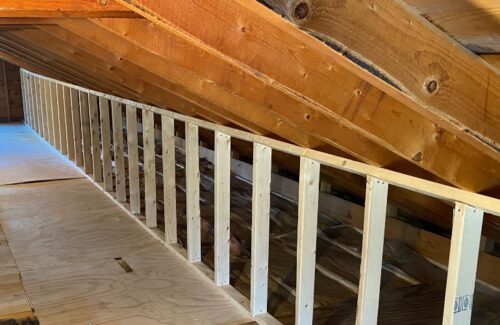Solar projects are commonly considered retrofit when it comes to residential installs. States like California are just starting to require certain solar capacities on new construction, but homes aren’t always built with solar projects in mind.
If a rooftop can’t handle the weight or penetrations from a solar system, it doesn’t necessarily mean the project must be canceled. Using wood blocks, residential rooftops can be reinforced from inside the attic and mounting points can be made between rafters.
Creating new attachment points with wood
Installing wood planks between roof rafters, also known as “wood blocking,” isn’t as common a practice as it used to be in solar installation. The need for wood blocking has been minimized by new solar mounting technology that can attach to roof decking in the space between rafters.
“We haven’t heard of a lot of installers blocking lately, but of course, there are situations where you have to block, so it’s a good thing to know, especially for new installers that get in the field that run into situations where they have to block and they don’t have good resources,” said Carlos Maldonado, training and technical support at mounting and racking manufacturer IronRidge.
Wood blocking may be necessary on houses with structural damage to the rafters, extra-long spans between rafters, rafter planks that aren’t thick enough for mounting lag bolts, roofs built with metal trusses or planned attachment points that don’t land on rafters.
Wood blocking is an approachable solution to creating new attachment points for solar mounts. Installers just need nails or wood screws, a circular saw and wood, preferably a 4×4 board. Maldonado recommends the 4×4 boards to give installers a larger surface area to attach to than the 1.5-in. space a typical 2×4 plank offers.
“It’s a standard 4×4, it doesn’t have to be special,” he said. “Most of them are pressure-treated, some aren’t, but that doesn’t really matter because it’s going to be in the attic so it’s not going to be exposed to the elements.”
After measuring the space between the rafters, installers cut the plank to that length and slide it between the rafters, securing it on both ends with screws or nails. That’s it — that’s wood blocking.
It’s necessary to have attic access to determine if wood blocking is necessary and to assess the condition of the rafters and support materials.
“The main thing is finding out exactly what’s below the structure and if the system’s able to handle the support,” Maldonado said.
Certain truss manufacturers will void warranties on penetrations to the supports. Standard rafters run north-south on a roof, and they’re supported by additional planks that run diagonally from the attic floor to the base of the rafter on truss-builds.
Metal roof supports can be C-shaped and have different embedment requirements than wooden rafters. They require specific metal fasteners, so it might be simpler to attach wood blocks between them for attachment points.
It is possible to install a rooftop solar array using only deck-mounted attachments, but Maldonado said the mounting spans will be reduced dramatically. Going that route also raises questions about the thickness and pullout values of the roofing material itself; not to mention the need for additional holes compared to single-attachment rafter mounts that go into decking.
“So, it’s going to come down to adding more mounts to accommodate not going into the structure,” he said.
Wood blocking can simplify a build thanks to fewer rafter attachment points.
Helping a roof hold more weight
Homes aren’t always built with the expectation that something will be installed on top of the roof. They’re built with specific engineering requirements for supporting the weight of the roof material and, in colder climates, snow loads
If a home can’t handle the additional weight of a solar array, there are methods to supporting the structure from the inside using wood boards.

Sistering requires attaching matching wood boards to damaged or sagging rafters in an attic. Granite State Solar
“It’s a relatively inexpensive solution to allow homeowners to go forward with their solar projects,” said Zach Olster, director of operations at Granite State Solar. “A company like us, based out of New Hampshire, we’re going to structure up a lot more roofs than a company out in California would.”
Granite State is a solar installation company that has offered roof restructuring from the start. The company consults an engineer before every installation. With data provided by its solar advisors, they create a roof report that details pertinent information like measurements of maximum unsupported lengths between rafters, the size of the wood planks used as supports, whether the home has horizontal support beams (collar ties) and the pitch of the roof.
The engineer calculates whether the roof needs restructured based on International Building Code standards and annual ground snow loads in the state.
“It’s not required, but we do it just to alleviate ourselves of the liability,” Olster said.
Roof restructuring isn’t that common, with about 15% of Granite State installs requiring it. But like wood blocking, it’s an accessible solution to a problem that installers might encounter.
There are two common methods for roof restructuring. The first is sistering, which is when matching wood planks are secured parallel to the original rafter — for example, 2×6 rafters would be sistered with 2×6 support boards. This addresses issues like cracked or rotted rafters or roof sag.
The amount of sistering required depends on the extent of rafter damage. If there is significant roof sag, then longer pieces of wood will be needed. Olster recommends first determining what planks the roof support was built with, typically 2x4s, 2x6s, 2x8s or 2x10s, and cutting those to length. If there is visible damage like a crack or rot, then the installer would cut the board so it extends beyond the affected area on both sides. A sagging roof can be propped up using wood as well by wedging the board between the rafter and the support running along the attic floor.
To attach the sister plank, Olster places it parallel to the affected rafter, drills pilot holes and drives in lag bolts. Additional embedment can be provided by nails.

Knee walls are a common method to supporting rooftops. Granite State Solar
The second method for roof restructuring is building in the attic a permanent support somewhat perpendicular to the ceiling called a knee wall.
Again, using matching wood, an installer will secure a base plate to the attic floor — or floor supports — that runs the length of the roof. A matching bevel plate is installed above the base plate, matching the pitch of the ceiling, running perpendicular across the rafters. Then studs cut at the top to match the angle of the bevel plate are placed and attached at both the base and bevel plates, also attaching to the rafter through the bevel.
Attics will likely have varying measurements from floor to ceiling at each rafter point, especially in older homes, so everything, particularly the studs, should be measured piece by piece to accommodate and properly support the structure.
“We don’t want to be responsible for a roof caving in and, essentially, if $1,000 is what’s between moving forward with your project or not, but it’s going to give you the peace of mind that your roof’s not going to cave in, I’d say it’s worth it,” Olster said.





would like a chance to comment on the structural reinforcement REQUIREMENTS in NH. Look into state fire code NFPA 1. It requires all solar installations in the state to have a structural PE evaluate the roof surface for viability. “It’s not required, but we do it just to alleviate ourselves of the liability,” is not factual. If the roof in question wants to be considered for a solar installation the roof needs to meet the requirements of the PE’s loading analysis, be reinforced to spec to meet 2015 IBC requirements, or sign a waiver with language referencing the exception of 2015 IBC Chapter 707.2, Addition or Replacement of Roofing, or Replacement of Equipment. I do not want to be quoted until I have a chance to speak with someone in person if available. I am an avid reader and have direct experience as I am the person who coordinates this interaction with a third party PE for this specific application.